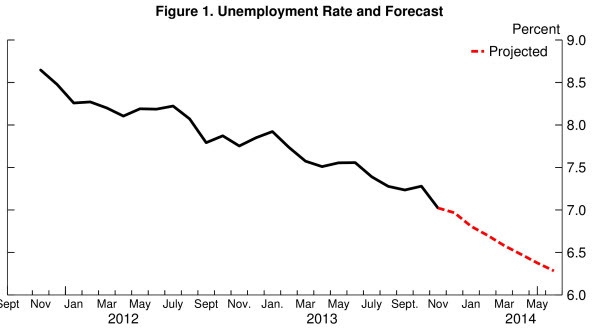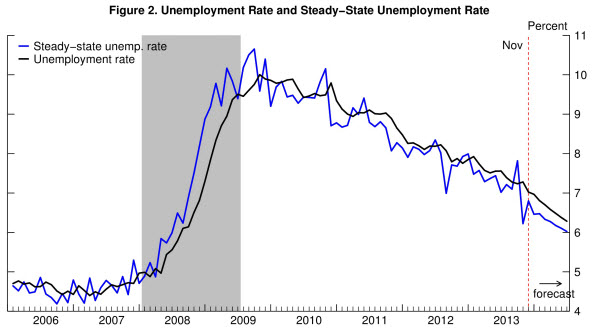This post discusses my monthly update of the Barnichon-Nekarda model. For an introduction to the basic concepts used in this post, read my introductory post (Full details are available here.)
In October, the unemployment rate decreased to 7.0%, as expected by the model as of September (before the government shutdown substantially distorted the October employment report [see my previous post]). My outlook for the labor market remains strong, in line with the September forecast. I expect unemployment to decline at a steady pace over the next six months with a decline of about 0.1 percentage points per month and an unemployment rate of 6.3% by June 2014.

Because our flow-approach to unemployment forecasting relies on worker flow data that are calculated from two consecutive employment reports, the distorted October employment report continues to affect our model’s unemployment forecast this month. To overcome this problem, I am relying this month on a slightly simpler forecasting model which performs as well as the usual model but relies much less heavily on the October employment report (and thus produces much more reliable forecasts in this particular instance). The only caveat is that the two-state model cannot forecast the labor force participation rate.
This model’s forecast can be easily understood, as with the usual model, by looking at the projected behavior of the “steady-state” unemployment rate. The steady-state unemployment rate, the rate of unemployment implied by the underlying labor force flows—the blue line in figure 2— stands currently at 6.5%. Our research shows that the actual unemployment rate converges toward this steady state. With a steady-state unemployment rate at a lower level than the actual rate (6.5 versus 7.0, a 0.5 percentage point difference), a “steady-state convergence dynamic” is pushing the unemployment rate down, implying a decline in unemployment going forward. Moreover, the model anticipates the steady-state unemployment rate (SSUR) to decline steadily in the coming month (figure 2). As a result, the gap between the unemployment rate and SSUR will remain substantial over the next 6 months, and the steady-state convergence dynamic will remain strong, pushing the unemployment rate down over the next 6 months.


To read more about the underlying model and the evidence that it outperforms other unemployment rate forecasts, see Barnichon and Nekarda (2012).



Commentary
Unemployment to Steadily Drop Over Next 6 Months
January 7, 2014